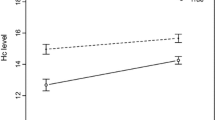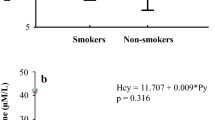Abstract
A moderate increase of total homocysteine (tHcy) plasma levels seems to increase cardiovascular disease (CVD) risk in Type 2 diabetic subjects, but its relationship with diabetes and insulin-resistance is still controversial. We examined whether mild hyperhomocysteinemia and its major genetic determinant would cluster with the metabolic syndrome (MS) in Type 2 diabetes. One hundred Type 2 diabetic subjects with and without MS were enrolled in the study. Fasting tHcy, vitamin B12, and folate plasma levels, insulin-resistance [assessed by homeostasis model assessment, (HOMAIR)] and the methylene tetrahydrofolate reductase (MTHFR) C677T genotype were assessed in all the participants. Geometric mean tHcy concentration and the prevalence of mild hyperhomocysteinemia, as commonly defined by tHcy ≥15 μmol/l, were comparable in diabetic subjects with and without MS, even after adjustment for age, sex, vitamin B12, folate and creatinine levels. In both groups, the MTHFR C677T genotype distribution was not significantly different from the Hardy-Weinberg equilibrium, with a TT homozygous frequency of 21% in subjects with and 18% in those without the syndrome (p=ns). tHcy plasma levels and the degree of insulin-resistance did not differ across MTHFR genotypes in both groups, even after multivariable adjustment. Overall, tHcy significantly correlated with creatinine (r=0.25; p=0.009) and trygliceride concentrations (r=0.24; p=0.02), but not with HOMAIR. At multivariate analysis, only creatinine was significantly correlated with tHcy levels (β=0.42; p=0.001). In conclusion, hyperhomocysteinemia and the common C677T variant of MTHFR gene are not associated with MS in Type 2 diabetic subjects. (J. Endocrinol. Invest. 29: 201–207, 2006)
Similar content being viewed by others
References
Reaven GM. Role of insulin resistance in human disease. Diabetes 1988, 37: 1595–607.
Haffner SM, Valdez RA, Hazuda HP, Mitchell BD, Morales PA, Stern MP. Prospective analysis of the insulin-resistance syndrome (syndrome X). Diabetes 1992, 41: 715–22.
Meigs JB, D’Agostino RB Sr, Wilson PW, Cupples LA, Nathan DM, Singer DE. Risk variable clustering in the insulin resistance syndrome. The Framingham Offspring Study. Diabetes 1997, 46: 1594–600.
DeFronzo RA, Ferrannini E. Insulin resistance. A multifaceted syndrome responsible for NIDDM, obesity,hypertension, dyslipidemia, and atherosclerotic cardiovascular disease. Diabetes Care 1991, 14: 173–94.
Kaplan NM. The deadly quartet. Upper-body obesity, glucose intolerance, hypertriglyceridemia, and hypertension. Arch Intern Med 1989, 149: 1514–20.
Alberti KG, Zimmet PZ. Definition, diagnosis and classification of diabetes mellitus and its complications. Part 1: diagnosis and classification of diabetes mellitus provisional report of a WHO consultation. Diabet Med 1998, 15: 539–53.
Bloomgarden ZT. Definitions of the insulin resistance syndrome: the 1st World Congress on the Insulin Resistance Syndrome. Diabetes Care 2004, 27: 824–30.
Groop L, Ekstrand A, Forsblom C, et al. Insulin resistance, hypertension and microalbuminuria in patients with type 2 (non-insulin-dependent) diabetes mellitus. Diabetologia 1993 36: 642–7.
Mykkanen L, Zaccaro DJ, Wagenknecht LE, Robbins DC, Gabriel M, Haffner SM. Microalbuminuria is associated with insulin resistance in nondiabetic subjects: the insulin resistance atherosclerosis study. Diabetes 1998, 47: 793–800.
Yudkin JS. Abnormalities of coagulation and fibrinolysis in insulin resistance. Evidence for a common antecedent? Diabetes Care 1999, 22 (Suppl 3): C25–30.
Pickup JC. Inflammation and activated innate immunity in the pathogenesis of type 2 diabetes. Diabetes Care 2004, 27: 813–23.
Kannel WB, McGee DL. Diabetes and glucose tolerance as risk factors for cardiovascular disease: the Framingham study. Diabetes Care 1979, 2: 120–6.
Isomaa B, Almgren P, Tuomi T, et al. Cardiovascular morbidity and mortality associated with the metabolic syndrome. Diabetes Care 2001, 24: 683–9.
Isomaa B, Henricsson M, Almgren P, Tuomi T, Taskinen MR, Groop L. The metabolic syndrome influences the risk of chronic complications in patients with type II diabetes. Diabetologia 2001, 44: 1148–54.
Bonora E, Kiechl S, Willeit J, et al. Carotid atherosclerosis and coronary heart disease in the metabolic syndrome: prospective data from the Bruneck study. Diabetes Care 2003, 26: 1251–7.
Welch GN, Loscalzo J. Homocysteine and atherothrombosis. N Engl J Med 1998, 338: 1042–50.
Yeromenko Y, Lavie L, Levy Y. Homocysteine and cardiovascular risk in patients with diabetes mellitus. Nutr Metab Cardiovasc Dis 2001, 11:108–16.
Audelin MC, Genest J Jr. Homocysteine and cardiovascular disease in diabetes mellitus. Atherosclerosis 2001, 159: 497–511.
Hoogeveen EK, Kostense PJ, Beks PJ, et al. Hyperhomocysteinemia is associated with an increased risk of cardiovascular disease, especially in non-insulin-dependent diabetes mellitus: a population-based study. Arterioscler Thromb Vasc Biol 1998, 18: 133–8.
Fonseca VA, Mudaliar S, Schmidt B, Fink LM, Kern PA, Henry RR. Plasma homocysteine concentrations are regulated by acute hyperinsulinemia in nondiabetic but not type 2 diabetic subjects. Metabolism 1998, 47: 686–9.
Dicker-Brown A, Fonseca VA, Fink LM, Kern PA. The effect of glucose and insulin on the activity of methylene tetrahydrofolate reductase and cystathionine-beta-synthase: studies in hepatocytes. Atherosclerosis 2001, 158: 297–301.
Frosst P, Blom HJ, Milos R, et al. Identification of a candidate genetic risk factor for vascular disease: A common mutation at the methylenetetrahydrofolate reductase locus. Nat Genet 1995, 10: 111–3.
Klerk M, Verhoef P, Clarke R, Blom HJ, Kok FJ, Schouten EG, the MTHFR Studies Collaboration Group. MTHFR 677 C—>T Polymorphism and risk of coronary heart disease. JAMA 2002, 288: 2023–31.
The Expert Committee on the Diagnosis and Classification of Diabetes Mellitus. Report of the Expert Committee on the Diagnosis and Classification of Diabetes Mellitus. Diabetes Care 1997, 20: 1183–97.
Matthews DR, Hosker JP, Rudeenski AS, Naylor BA, Treacher DF, Turner RC. Homeostasis model assessment:insulin resistance and beta-cell function from fasting plasma glucose and insulin concentrations in man. Diabetologia 1985, 28: 412–9.
Araki A, Sako Y. Determination of free and total homocysteine in human plasma by high-performance liquid chromatography with fluorescence detection. J Chromatogr 1987, 442: 43–52.
Christenson RH, Dent GA, Tuszynski A. Two radioassays for serum vitamin B12 and folate determination compared in a reference interval study. Clin Chem 1985, 31: 1358–60.
Rose GA, Blackburn H. Cardiovascular survey methods. WHO Monograph Series No. 56. Geneva: World Health Organization, 1968.
Graham IM, Daly LE, Refsum HM, et al. Plasma homocysteine as a risk factor for vascular disease. The European Concerted Action Project. JAMA 1997, 277: 1775–81.
Lanfredini M, Fiorina P, Peca M, et al. Fasting and post-methionine load homocysteine values are correlated with microalbuminuria and could contribute to worsening vascular damage in non-insulin-dependent diabetes mellitus patients. Metabolism 1998, 47: 915–21.
Chico A, Perez A, Cordoba A, et al. Plasma homocysteine is related to albumin excretion rate in patients with diabetes mellitus: a new link between diabetic nephropathy and cardiovascular disease? Diabetologia 1998, 41: 684–93.
Jager A, Kostense PJ, Nijpels G, et al. Serum homocysteine levels are associated with the development of (micro)albuminuria: the Hoorn study. Arterioscler Thromb Vasc Biol 2001, 21: 74–81.
Friedman AN, Hunsicker LG, Selhub J, Bostom AG, The Collaborative Study Group. Proteinuria as a predictor of total plasma homocysteine levels in type 2 diabetic nephropathy. Diabetes Care 2002, 25: 2037–41.
Stabler SP, Estacio R, Jeffers BW, Cohen JA, Allen RH, Schrier RW. Total homocysteine is associated with nephropathy in non-insulin-dependent diabetes mellitus. Metabolism 1999, 48: 1096–101.
Russo GT, Di Benedetto A, Giorda C, et al. Correlates of total homocysteine plasma concentration in type 2 diabetes. Eur J Clin Invest 2004, 34: 197–204.
Jacques PF, Bostom AG, Wilson PW, Rich S, Rosenberg IH, Selhub J. Determinants of plasma total homocysteine concentration in the Framingham Offspring cohort. Am J Clin Nutr 2001, 73: 613–21.
Giltay EJ, Hoogeveen EK, Elbers JM, Gooren LJ, Asscheman H, Stehouwer CD. Insulin resistance is associated with elevated plasma total homocysteine levels in healthy, non-obese subjects. Atherosclerosis 1998, 139: 197–8.
Meigs JB, Jacques PF, Selhub J, et al. Fasting plasma homocysteine levels in the insulin resistance syndrome: the Framingham offspring study. Diabetes Care 2001, 24: 1403–10.
De Pergola G, Pannacciulli N, Zamboni M, et al. Homocysteine plasma levels are independently associated with insulin resistance in normal weight, overweight and obese pre-menopausal women. Diabetes Nutr Metab 2002, 14: 253–8.
Sanchez-Margalet V, Valle M, Ruz FJ, Gascon F, Mateo J, Goberna R. Elevated plasma total homocysteine levels in hyperinsulinemic obese subjects. J Nutr Biochem 2002, 13: 75–9.
Godsland IF, Rosankiewicz JR, Proudler AJ, Johnston DG. Plasma total homocysteine concentrations are unrelated to insulin sensitivity and components of the metabolic syndrome in healthy men. J Clin Endocrinol Metab 2001, 86: 719–23.
Veerkamp MJ, de Graaf J, den Heijer M, Blom HJ, Stalenhoef AF. Plasma homocysteine in subjects with familial combined hyperlipidemia. Atherosclerosis 2003, 166: 111–7.
Abbasi F, Facchini F, Humphreys MH, Reaven GM. Plasma homocysteine concentrations in healthy volunteers are not related to differences in insulin-mediated glucose disposal.Atherosclerosis 1999, 146: 175–8.
Sheu WH, Lee WJ, Chen YT. Plasma homocysteine concentrations and insulin sensitivity in hypertensive subjects. Am J Hypertens 2000, 13(1 Pt 1): 14–20.
Rosolova H, Simon J, Mayer O Jr, Racek J, Dierze T, Jacobsen DW. Unexpected inverse relationship between insulin resistance and serum homocysteine in healthy subjects. Physiol Res 2002, 51: 93–8.
Fonseca VA, Fink LM, Kern PA. Insulin sensitivity and plasma homocysteine concentrations in non-diabetic obese and normal weight subjects. Atherosclerosis 2003, 167:105–9.
Emoto M, Kanda H, Shoji T, et al. Impact of insulin resistance and nephropathy on homocysteine in type 2 diabetes. Diabetes Care 2001, 24: 533–8.
Buysschaert M, Dramais A-S, Wallemacq PE, Hermans M. Hyperhomocysteinemia in type 2 diabetes. Diabetes Care 2000, 23: 1816–22.
Jermendy G, Hidvegi T, Hetyesi K. Plasma homocysteine levels in hyperinsulinemic subjects. Diabetes Care 2000, 23: 1852–3.
Selhub J, Miller JW. The pathogenesis of homocysteinemia: interruption of the coordinate regulation by S-adenosylmethionine of the remethylation and transsulfuration of homocysteine. Am J Clin Nutr 1992, 55: 131–8.
Stuppia L, Gatta V, Scarciolla O, et al. The methylenetethrahydrofolate reductase (MTHFR) C677T polymorphism and male infertility in Italy. J Endocrinol Invest 2003, 26: 620–2.
Stuppia L, Gatta V, Gaspari AR, et al. C677T mutation in the 5,10-MTHFR gene and risk of Down syndrome in Italy. Eur J Hum Genet 2002, 10: 388–90.
Author information
Authors and Affiliations
Corresponding author
Rights and permissions
About this article
Cite this article
Russo, G.T., Di Benedetto, A., Alessi, E. et al. Mild hyperhomocysteinemia and the common C677T polymorphism of methylene tetrahydrofolate reductase gene are not associated with the metabolic syndrome in Type 2 diabetes. J Endocrinol Invest 29, 201–207 (2006). https://doi.org/10.1007/BF03345540
Accepted:
Published:
Issue Date:
DOI: https://doi.org/10.1007/BF03345540




